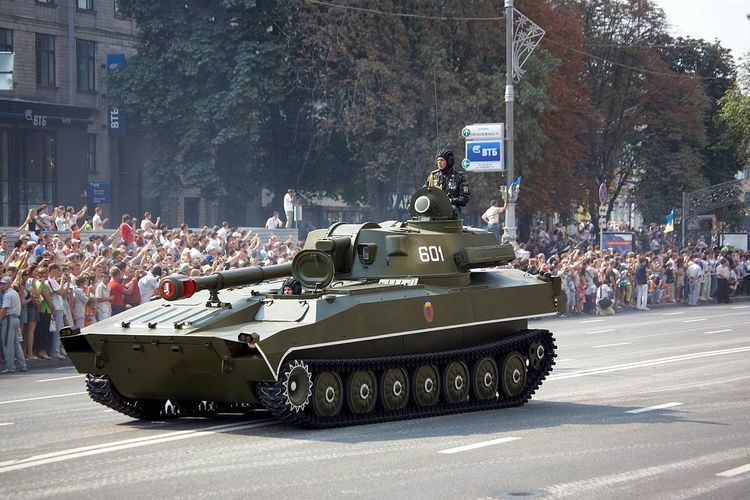The 2S1 Gvozdika (Russian: 2С1 «Гвоздика», "Carnation") is a Soviet self-propelled howitzer based on the chassis MT-LB APC, mounting the 122 mm 2A18 howitzer. "2S1" is its GRAU designation. An alternative Russian designation is SAU-122 but in the Russian Army it is commonly known as Gvozdika. The 2S1 is fully amphibious with very little preparation, and once afloat is propelled by its tracks. A variety of wider tracks are also available to allow the 2S1 to operate in snow or swamp conditions. It is NBC protected and has infra-red night-vision capability.
The 2S1 has seven road wheels on each side; the running gear can be fitted with different widths of track to match terrain. The interior is separated into a driver's compartment on the left, an engine compartment on the right and a fighting compartment to the rear. Within the fighting compartment the commander sits on the left, the loader on the right and the gunner to the front. The all-welded turret is located above the fighting compartment. The 2S1 utilizes a 122 mm howitzer based on the towed D-30 howitzer. The gun is equipped with a power rammer, a double-baffle muzzle brake and a fume extractor. It is capable of firing HE (high explosive), leaflet, HE/RAP, armor-piercing HE, flechette and chemical rounds.
The first prototype was ready in 1969. The 2S1 entered service with the Soviet Army in the early 1970s and was first seen in public at a Polish Army parade in 1974. The vehicle was deployed in large numbers (72 per tank division, 36 per motorized rifle division). It was designated the M1974 by the U.S. Army and manufactured in Bulgarian, Polish and Russian state factories.
2S34 "Hosta" – Modernisation of the 2S1 with the 122 mm 2A31 gun replaced by the 120 mm 2A80. Further improvements include a new fire control system, a battlefield observation system and the ability to fire the Kitolov-2M guided ammunition. One unit, the 21st Mechanized Brigade in Totskoye is currently being equipped with the system.2S15 "Norov" – A prototype tank destroyer equipped with a radar-based fire control system and a 100 mm gun.Poland
The 2S1 Gvozdika (as well as other related vehicles such as the MT-LB and Opal) were produced in Poland by Huta Stalowa Wola under the name 2S1 Goździk.
2S1M Goździk – Version with special amphibious kit that increases the vehicle's amphibious capabilities.2S1T Goździk – Version with a TOPAZ digital fire control system from WB electronics. The system consists of a FONET-IP digital intercom system, new digital radio, military GPS receiver, military computer and dedicated software. The same system is used on other Polish Armed Forces artillery systems like the AHS Krab, Dana-T and WR-40 Langusta.Model 89 – Romanian variant that uses a modified version of the hull of the MLI-84.Raad-1 ('thunder') – Iranian variant that is based on the hull of the Boragh APC. Algeria – 145 Angola Armenia – Azerbaijan – 81 2S1 and unknown number of UR-77 Bosnia and Herzegovina – 5 Belarus – 246 Bulgaria – 506 Cuba – 150 Croatia – 9 (to be used alongside 15 Panzerhaubitze 2000 from German Army stock.) Eritrea – 20 Ethiopia Finland – 72 (known as 122 PsH 74) Georgia 48 India – 110 (to be replaced) Iran Iraq Kazakhstan – 10 Libya Poland – c. 324 (to be replaced by SMK Rak) South Ossetia Serbia – 72 Slovakia – 49 Syria – 400 Russia – 622 Ukraine – 638 Uruguay – 6 Uzbekistan Vietnam Yemen Czech Republic – Phased out in early 2000s (decade) Czechoslovakia – Passed on to successor states East Germany – Phased out in 1990 after German reunification Hungary - Phased out in 2004. Original there were 144 pieces of Gvozdikas. Romania – 48 reserve status since 2005 Slovenia – 8 reserve status Soviet Union – Passed on to successor states Yugoslavia – Passed on to successor states.Afghanistan – Soviet war in AfghanistanChechnya (Russia) – Second Chechen War (1999 to 2000)Iraq – First Gulf War, Second Gulf WarYugoslavia – Yugoslav Wars, Kosovo WarGeorgia – 2008 South Ossetia warLibya – 2011 Libyan civil warSyria – Syrian civil warUkraine – War in Donbass
